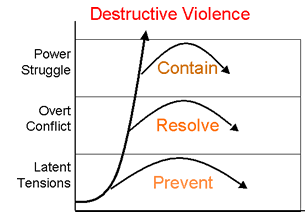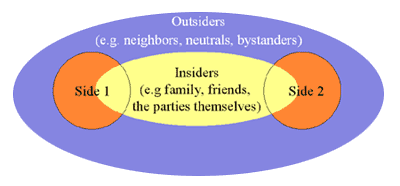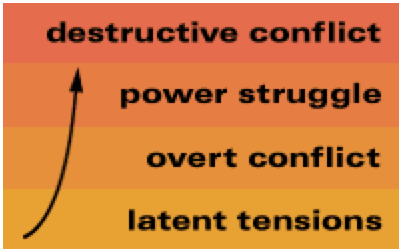Mediator – Reconcile Conflicting Interests
At the core of conflict are often conflicting interests. As Mediators, we can help reconcile the parties’ interests. The Mediator does not seek to determine who is right and who is wrong, but rather tries to get to the core of the dispute and help the parties resolve it. We may not think of it as mediation, but that is what we are doing whenever we listen attentively to people in dispute, when we ask them about what they really want, when we suggest possible approaches, and when we urge them to think hard about the costs of not reaching agreement.
Recall that everyone is a mediator
- Jonah, four-and-a-half-years-old, occasionally mediates between his two older brothers, ages eight and twelve. When an argument breaks out, he holds up his hands and says, “Okay, stop fighting!” He shuttles back and forth between them, explaining to each brother how the other one feels, and often brings about a reconciliation.
Like Jonah, each of us has a chance to mediate every day, at least in an informal sense. Parents can mediate among their children and children between their parents. Supervisors can mediate among their employees and employees between their bosses. Colleagues can mediate among their peers, managers among their team-mates, and friends among their friends.
Splitting the difference between two opposed positions is often not satisfactory. A Mediator can help the parties meet the interests – the concerns, desires, and aspirations – underlying those positions.
- One family dispute among the Bushmen, for example, concerned a certain betrothal gift from the bride’s mother that the groom’s mother had expected would go to her present husband but was given to someone else instead. Through a process of community mediation, the parties agreed a few days later that the stepfather would receive a gift, not the one in question, but one which satisfied everyone so that, as one Bushman put it, “they could all start again in peace.” Even if the position, the particular item in question, was not obtained, the underlying interest in recognizing the stepfather and the community’s interest in harmony were fulfilled.
Bring the parties to the table
The first step is to get people to sit down together.
Sometimes, the community can require the parties to go through the mediation process.
- Some American schools, for example, demand that students who have been suspended for violence – or other reasons – resolve any outstanding disputes with other students, teachers, or administrators before they can return. The mediation sessions include parents and other significant people in their lives who constitute the Third Side. “We are strict about not letting unresolved conflicts fester,” explains one assistant principal. “The school has a different atmosphere than before we instituted the program.”
If the parties are not ready to meet, a Mediator can still help by using shuttle diplomacy.
- In one union-management conflict, personal relationships were so strained and distrust so high that it was better to make some progress first in separate meetings with each side. Only when agreement seemed near, to the surprise of both sides, was there success in bringing them together for constructive talks.
Facilitate communication
One of the Mediator’s key functions is to help each side understand what the other is really saying or asking for.
- One union-management negotiation became stuck on the issue of “attendance.” Management complained that many employees were regularly absent; they wanted the union’s help in improving attendance. The union officials refused even to discuss the subject. Upon questioning them closely, it was discovered that much of their resistance came from the word “attendance.” “People feel treated like schoolchildren, being reprimanded by the teacher for not showing up for class!” exclaimed one union leader. Interestingly, once the issue was reframed as “increasing worker participation,” the union leaders became much more responsive. Participation was a positive issue they could support.
Simple ground rules can help:
- One rule that has helped prevent angry escalating exchanges is: Only one person can get angry at a time. The other person listens, knowing he or she will get a turn later.
- Another rule dates back at least as far as the Middle Ages, when theologians at the University of Paris used it to facilitate mutual understanding: One can speak only after one has repeated what the other side has said to that person’s satisfaction.
Help people search for a solution
The next step is to help the parties generate creative options for agreement.
- “The students, not the mediators, make suggestions on how to solve the conflict,” explains one twelve-year-old peer mediator. “The mediator sums up the plan or the agreement that was reached.”
Ideally, the solution does come from the parties themselves. Sometimes, however, the Mediator can advance the process by proposing solutions for the parties to consider. Because many people tend to distrust ideas offered by the other side, an option suggested by the Mediator may prove easier for both sides to accept.
The goal is a mutually satisfactory agreement:
- One dispute between a big department store in Johannesburg and the street vendors camped on the sidewalk outside had escalated into a bitter fight. The store wanted the vendors to move, but the vendors refused. The store then enlisted the help of the police who, encountering fierce resistance, were reluctant to risk a violent confrontation. The deadlock was broken with the help of a community mediator, who began by probing for each side’s interests. The store’s managers, it turned out, feared that the vendors would scare away customers and damage its public image; the vendors just wanted a busy place to sell their wares. A creative brainstorming session resulted in a decision by the store to help the vendors set up proper booths, which enhanced the vendors’ business as well as the street’s appearance. In return, the vendors promised to keep the street clean and to look out for thieves, who had become a major problem for the store. Having begun as adversaries, the parties ended up as partners – thanks to mediation.
Resources
- Mediation Information and Resource Center
- Global Arbitration Mediation Association, Inc.
- Federal Mediation and Conciliation Services
- School Mediation Associates
- ADR Resources
Brief bibliography
- Beer, J. and E. Stief. (1997) Mediator’s Handbook Third Edition. New Society Publishing.
- Bush, B. and J. Folger. (1994) The promise of mediation: Responding to conflict through empowerment and recognition. San Francisco: Jossey Bass.
- Moore, Christopher. (1996) The Mediation Process: Practical Strategies for Resolving Conflict Second Edition. San Francisco: Jossey Bass.
- Ury, William (2000). The Third Side:Why We Fight and How We Can Stop. New York: Penguin.




